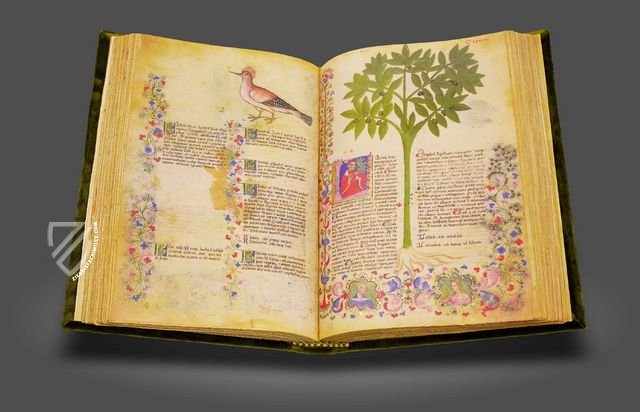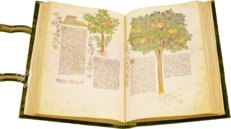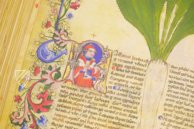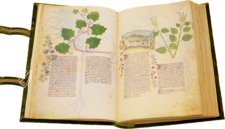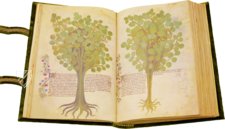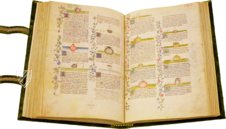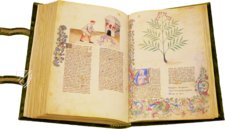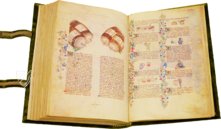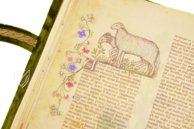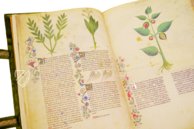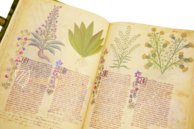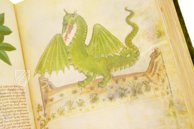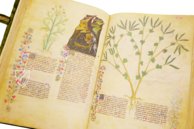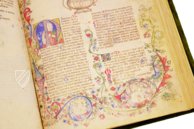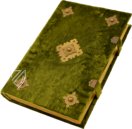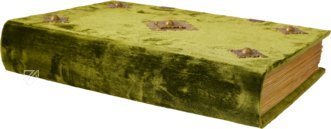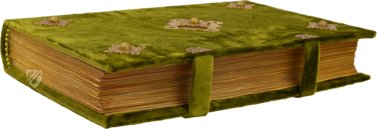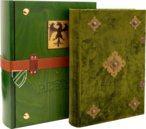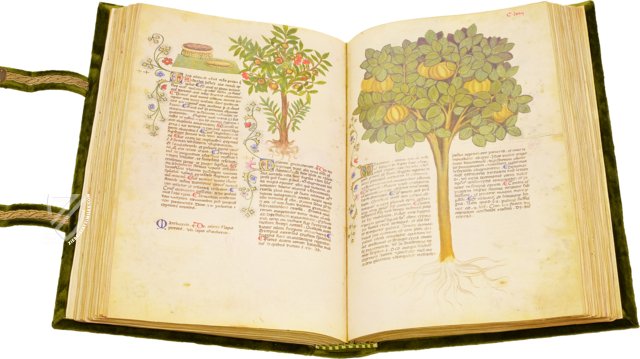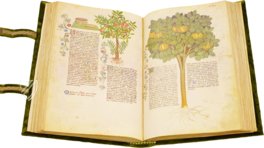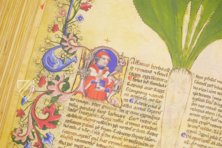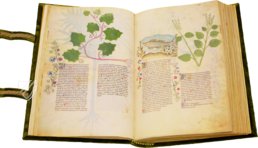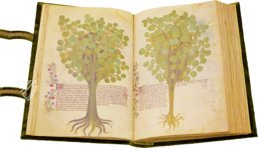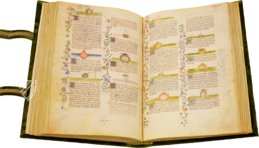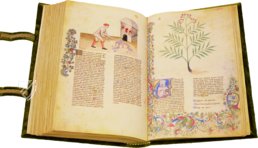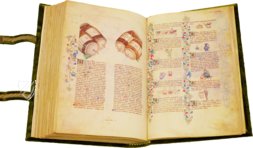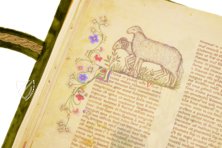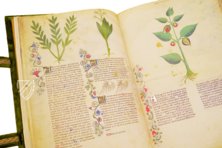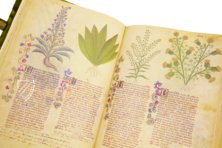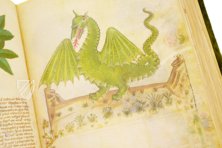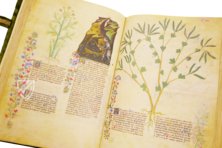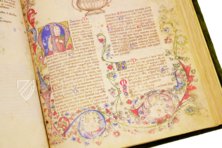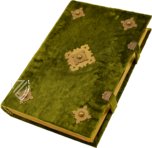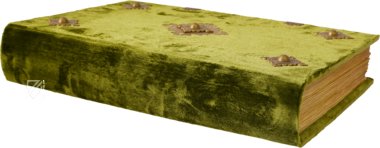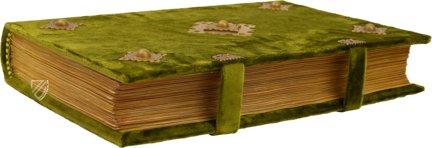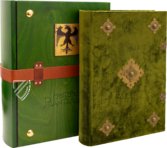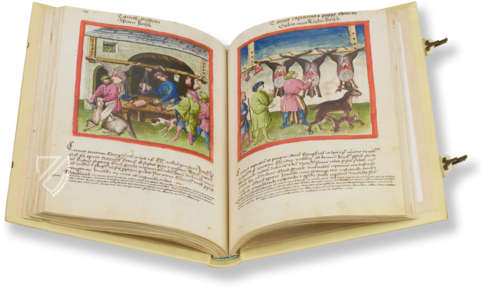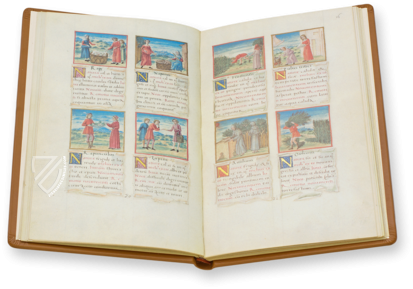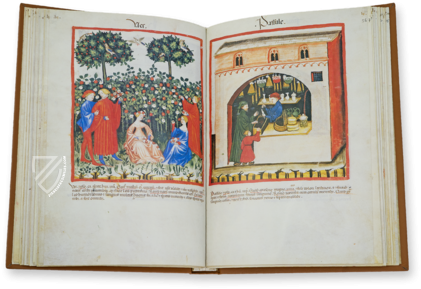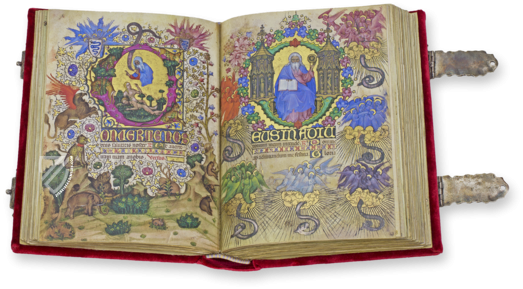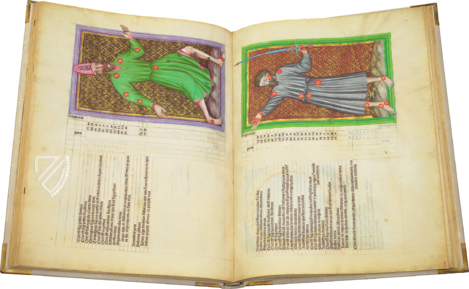Historia Plantarum
(3,000€ - 7,000€)
This codex, known as the Historia Plantarum, was created at the end of the 14th century at the court of Gian Galeazzo Visconti in Milan. It is a comprehensive medical encyclopedia dealing with plant, animal, and mineral agents and their advantages and disadvantages for the human body, based on the work of the Persian scholar Ibn Butlan. The fascinating manuscript is adorned with more than 500 high-quality botanical illustrations, as well as miniatures of animals, minerals, and everyday objects. Arranged in alphabetical order, the lemmas of this medieval reference book are marked by gold-decorated and sometimes historiated initials, often accompanied by ornate floral borders and curlicues. The Duke of Milan gifted the splendid manuscript to Wenceslaus IV, King of Bohemia and Germany to help cement their alliance. It can thus be accurately said that this is a manuscript worthy of a king.
Historia Plantarum
In the 11th century, the doctor Ibn Butlan composed the medical work Taqwim es-sihha. The Latin book series Tacuinum Sanitatis was based on the foundation of this work. Included among them are exquisite illuminated codices, which are found today in Vienna, Rome, London, and Paris. Rome’s Historia Plantarum, a work from this series, represents an exhaustive encyclopedia of the natural sciences with descriptions of plants, minerals, and animals. Special interest was shown to the specific medicinal and therapeutic effects of floral and faunal substances. The codex contains more than 500 beautiful and illustrative depictions of plans and over 80 depictions of animals.
Medicine in the Middle Ages
The Historia Plantarum is an interesting and historically significant source about medicine and also about the everyday life of the Middle Ages. According to medieval doctors, various elements were needed for a healthy lifestyle: proper diet, exercise and enough sleep, and a balanced emotional state. A life in harmony with nature was recommended. This guaranteed people health and well-being. The illuminated manuscript is illustrated with over five hundred illustrations of plants in alphabetical order. The depictions convey an astoundingly detailed and imposing overview of the thorough knowledge about plant life, which one possessed in late medieval Italy. In addition to these botanical pictures come more than eighty illustrations of animals, from which one obtained healing remedies, as well as over 30 depictions of mineral derivatives.
Prominent Previous Owners
The manuscript was made at the end of the 14th century at the court of Gian Galeazzo Visconti. The ruler was the most powerful and glorious scion of the great Visconti family and created during his reign one of the most impressive collections of unbelievably valuable book treasures. Gian Galeazzo presented the splendid Historia Plantarum to Wenceslas IV, King of Bohemia and Germany, with whom he forged a good political relationship. Today the medical encyclopedia is found in the Biblioteca Casanatense in Rome.
Codicology
- Alternative Titles
- Medizinische Enzyklopädie Kaiser Wenzels
Tacuinum sanitatis
Casanatense Tacuinum Sanitatis - Size / Format
- 590 pages / 46.0 × 32.0 cm
- Origin
- Italy
- Date
- End of the 14th century
- Epochs
- Style
- Language
- Illustrations
- More than 500 illustrations of plants and 80 illustration of animals
- Content
- Exhaustive encyclopedia of the natural sciences with descriptions of plants, minerals, and animals based on texts by Ibn Butlan
- Patron
- Gian Galeazzo Visconti (1351–1402)
- Artist / School
- Visconti court scriptorium in Milan
- Previous Owners
- Wenceslas IV, King of Bohemia and Germany (1361–1419)
Historia Plantarum
Portrait of Wenceslaus IV
On folio 1r, a rather large portrait depicts Wenceslas surrounded the six electors of the Holy Roman Empire before a mosaic background of blue, red, and gold. Dressed in armor and carrying swords, the secular prince-electors stand on the right dressed in their respective coats of arms while the archbishops of Mainz, Trier, and Cologne stand to the left. Wenceslaus is shown confidently enthroned with the imperial regalia but will be disposed within a few years of when this miniature was made.
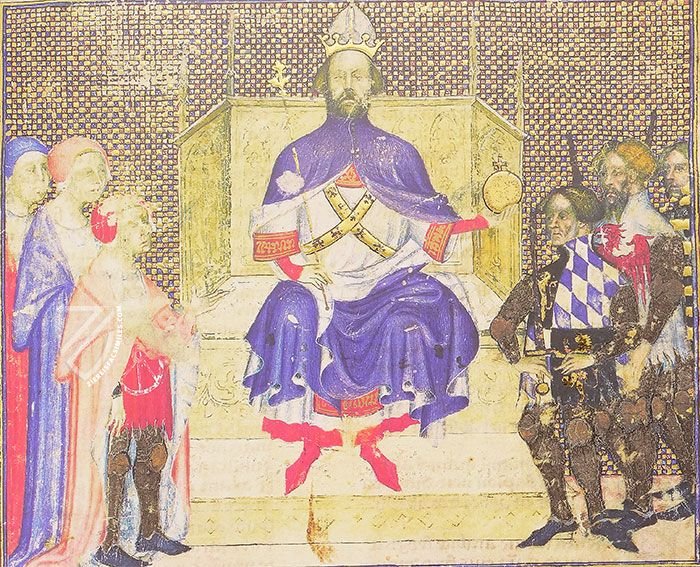
Historia Plantarum
Elephant
Despite its name, this manuscript also depicts dozens of animals including creatures of fantasy like dragons and real animals like elephants that were just as strange and exotic to medieval Europeans. The elephant is nearly as tall as a tree with the bushes grazing its stomach. It is depicted with a stern expression and its ears have a splendid fall of folds.
The margins of the page are filled with rich tendrils of red and blue that also incorporate some Gothic architectural elements. Although the identity of the three figures is unclear, there are some clues. In the historiated initial, the man’s garments and gestures suggest that he is a scholar, while the figures in the medallions resemble members of the nobility, possibly his students.
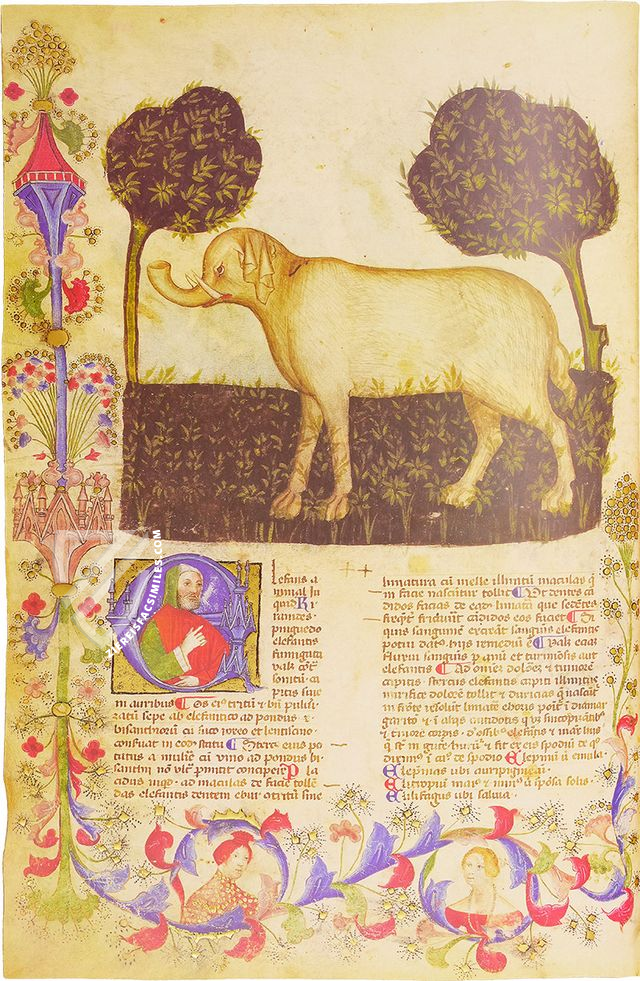
#1 Historia Plantarum
Language: Italian
(3,000€ - 7,000€)
- Treatises / Secular Books
- Apocalypses / Beatus
- Astronomy / Astrology
- Bestiaries
- Bibles / Gospels
- Chronicles / History / Law
- Geography / Maps
- Saints' Lives
- Islam / Oriental
- Judaism / Hebrew
- Single Leaf Collections
- Leonardo da Vinci
- Literature / Poetry
- Liturgical Manuscripts
- Medicine / Botany / Alchemy
- Music
- Mythology / Prophecies
- Psalters
- Other Religious Books
- Games / Hunting
- Private Devotion Books
- Other Genres
- Afghanistan
- Armenia
- Austria
- Belgium
- Belize
- Bosnia and Herzegovina
- China
- Colombia
- Costa Rica
- Croatia
- Cyprus
- Czech Republic
- Denmark
- Egypt
- El Salvador
- Ethiopia
- France
- Germany
- Greece
- Guatemala
- Honduras
- Hungary
- India
- Iran
- Iraq
- Israel
- Italy
- Japan
- Jordan
- Kazakhstan
- Kyrgyzstan
- Lebanon
- Liechtenstein
- Luxembourg
- Mexico
- Morocco
- Netherlands
- Palestine
- Panama
- Peru
- Poland
- Portugal
- Romania
- Russia
- Serbia
- Spain
- Sri Lanka
- Sweden
- Switzerland
- Syria
- Tajikistan
- Turkey
- Turkmenistan
- Ukraine
- United Kingdom
- United States
- Uzbekistan
- Vatican City
- A. Oosthoek, van Holkema & Warendorf
- Aboca Museum
- Ajuntament de Valencia
- Akademie Verlag
- Akademische Druck- u. Verlagsanstalt (ADEVA)
- Aldo Ausilio Editore - Bottega d’Erasmo
- Alecto Historical Editions
- Alkuin Verlag
- Almqvist & Wiksell
- Amilcare Pizzi
- Andreas & Andreas Verlagsbuchhandlung
- Archa 90
- Archiv Verlag
- Archivi Edizioni
- Arnold Verlag
- ARS
- Ars Magna
- ArtCodex
- AyN Ediciones
- Azimuth Editions
- Badenia Verlag
- Bärenreiter-Verlag
- Belser Verlag
- Belser Verlag / WK Wertkontor
- Benziger Verlag
- Bernardinum Wydawnictwo
- BiblioGemma
- Biblioteca Apostolica Vaticana (Vaticanstadt, Vaticanstadt)
- Bibliotheca Palatina Faksimile Verlag
- Bibliotheca Rara
- Boydell & Brewer
- Bramante Edizioni
- Bredius Genootschap
- Brepols Publishers
- British Library
- C. Weckesser
- Caixa Catalunya
- Canesi
- CAPSA, Ars Scriptoria
- Caratzas Brothers, Publishers
- Carus Verlag
- Casamassima Libri
- Centrum Cartographie Verlag GmbH
- Chavane Verlag
- Christian Brandstätter Verlag
- Circulo Cientifico
- Club Bibliófilo Versol
- Club du Livre
- CM Editores
- Collegium Graphicum
- Collezione Apocrifa Da Vinci
- Comissão Nacional para as Comemorações dos Descobrimentos Portugueses
- Coron Verlag
- Corvina
- CTHS
- D. S. Brewer
- Damon
- De Agostini/UTET
- De Nederlandsche Boekhandel
- De Schutter
- Deuschle & Stemmle
- Deutscher Verlag für Kunstwissenschaft
- DIAMM
- Droz
- E. Schreiber Graphische Kunstanstalten
- Ediciones Boreal
- Ediciones Grial
- Ediclube
- Edições Inapa
- Edilan
- Editalia
- Edition Deuschle
- Edition Georg Popp
- Edition Leipzig
- Edition Libri Illustri
- Editiones Reales Sitios S. L.
- Éditions de l'Oiseau Lyre
- Editions Medicina Rara
- Editorial Casariego
- Editorial Mintzoa
- Editrice Antenore
- Editrice Velar
- Edizioni Edison
- Egeria, S.L.
- Eikon Editores
- Electa
- Emery Walker Limited
- Enciclopèdia Catalana
- Eos-Verlag
- Ephesus Publishing
- Ernst Battenberg
- Eugrammia Press
- Extraordinary Editions
- Fackelverlag
- Facsimila Art & Edition
- Facsimile Editions Ltd.
- Facsimilia Art & Edition Ebert KG
- Faksimile Verlag
- Feuermann Verlag
- Folger Shakespeare Library
- Franco Cosimo Panini Editore
- Friedrich Wittig Verlag
- Fundación Hullera Vasco-Leonesa
- G. Braziller
- Gabriele Mazzotta Editore
- Gebr. Mann Verlag
- Gesellschaft für graphische Industrie
- Getty Research Institute
- Giovanni Domenico de Rossi
- Giunti Editore
- Graffiti
- Grafica European Center of Fine Arts
- Guido Pressler
- Guillermo Blazquez
- Gustav Kiepenheuer
- H. N. Abrams
- Harrassowitz
- Harvard University Press
- Helikon
- Hendrickson Publishers
- Henning Oppermann
- Herder Verlag
- Hes & De Graaf Publishers
- Hoepli
- Holbein-Verlag
- Houghton Library
- Hugo Schmidt Verlag
- Idion Verlag
- Il Bulino, edizioni d'arte
- ILte
- Imago
- Insel Verlag
- Insel-Verlag Anton Kippenberger
- Instituto de Estudios Altoaragoneses
- Instituto Nacional de Antropología e Historia
- Introligatornia Budnik Jerzy
- Istituto dell'Enciclopedia Italiana - Treccani
- Istituto Ellenico di Studi Bizantini e Postbizantini
- Istituto Geografico De Agostini
- Istituto Poligrafico e Zecca dello Stato
- Italarte Art Establishments
- Jan Thorbecke Verlag
- Johnson Reprint Corporation
- Josef Stocker
- Josef Stocker-Schmid
- Jugoslavija
- Karl W. Hiersemann
- Kasper Straube
- Kaydeda Ediciones
- Kindler Verlag / Coron Verlag
- Kodansha International Ltd.
- Konrad Kölbl Verlag
- Kurt Wolff Verlag
- La Liberia dello Stato
- La Linea Editrice
- La Meta Editore
- Lambert Schneider
- Landeskreditbank Baden-Württemberg
- Leo S. Olschki
- Les Incunables
- Liber Artis
- Library of Congress
- Libreria Musicale Italiana
- Lichtdruck
- Lito Immagine Editore
- Lumen Artis
- Lund Humphries
- M. Moleiro Editor
- Maison des Sciences de l'homme et de la société de Poitiers
- Manuscriptum
- Martinus Nijhoff
- Maruzen-Yushodo Co. Ltd.
- MASA
- Massada Publishers
- McGraw-Hill
- Metropolitan Museum of Art
- Militos
- Millennium Liber
- Müller & Schindler
- Nahar - Stavit
- Nahar and Steimatzky
- National Library of Wales
- Neri Pozza
- Nova Charta
- Oceanum Verlag
- Odeon
- Orbis Mediaevalis
- Orbis Pictus
- Österreichische Staatsdruckerei
- Oxford University Press
- Pageant Books
- Parzellers Buchverlag
- Patrimonio Ediciones
- Pattloch Verlag
- PIAF
- Pieper Verlag
- Plon-Nourrit et cie
- Poligrafiche Bolis
- Presses Universitaires de Strasbourg
- Prestel Verlag
- Princeton University Press
- Prisma Verlag
- Priuli & Verlucca, editori
- Pro Sport Verlag
- Propyläen Verlag
- Pytheas Books
- Quaternio Verlag Luzern
- Reales Sitios
- Recht-Verlag
- Reichert Verlag
- Reichsdruckerei
- Reprint Verlag
- Riehn & Reusch
- Roberto Vattori Editore
- Rosenkilde and Bagger
- Roxburghe Club
- Salerno Editrice
- Saltellus Press
- Sandoz
- Sarajevo Svjetlost
- Schöck ArtPrint Kft.
- Schulsinger Brothers
- Scolar Press
- Scrinium
- Scripta Maneant
- Scriptorium
- Shazar
- Siloé, arte y bibliofilia
- SISMEL - Edizioni del Galluzzo
- Sociedad Mexicana de Antropología
- Société des Bibliophiles & Iconophiles de Belgique
- Soncin Publishing
- Sorli Ediciones
- Stainer and Bell
- Studer
- Styria Verlag
- Sumptibus Pragopress
- Szegedi Tudomànyegyetem
- Taberna Libraria
- Tarshish Books
- Taschen
- Tempus Libri
- Testimonio Compañía Editorial
- Thames and Hudson
- The Clear Vue Publishing Partnership Limited
- The Facsimile Codex
- The Folio Society
- The Marquess of Normanby
- The Richard III and Yorkist History Trust
- Tip.Le.Co
- TouchArt
- TREC Publishing House
- TRI Publishing Co.
- Trident Editore
- Tuliba Collection
- Typis Regiae Officinae Polygraphicae
- Union Verlag Berlin
- Universidad de Granada
- University of California Press
- University of Chicago Press
- Urs Graf
- Vallecchi
- Van Wijnen
- VCH, Acta Humaniora
- VDI Verlag
- VEB Deutscher Verlag für Musik
- Verlag Anton Pustet / Andreas Verlag
- Verlag Bibliophile Drucke Josef Stocker
- Verlag der Münchner Drucke
- Verlag für Regionalgeschichte
- Verlag Styria
- Vicent Garcia Editores
- W. Turnowski Ltd.
- W. Turnowsky
- Waanders Printers
- Wiener Mechitharisten-Congregation (Wien, Österreich)
- Wissenschaftliche Buchgesellschaft
- Wissenschaftliche Verlagsgesellschaft
- Wydawnictwo Dolnoslaskie
- Xuntanza Editorial
- Zakład Narodowy
- Zollikofer AG

